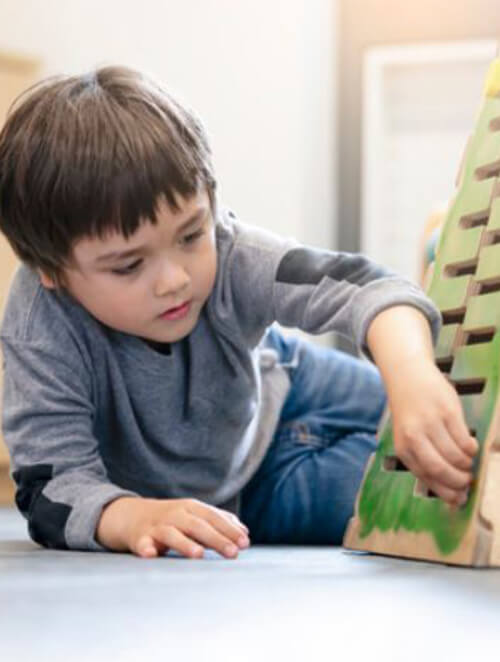Learning to Play with Your Baby – All You Need to Know
 16721
16721

super easy
While gearing up for parenting and caring for your lovely little one, you may have already realized that playtime is very special. As is wisely said by Mister Rogers, “Play is often talked about as if it is a relief from serious learning. But for children, play is serious learning. Play is really the work of childhood.” Not only is play fun, but it is also critical for a child’s development. For your precious toddler, play is not just entertainment, but it is their “work” and the way of learning the world surrounding them.
Little ones between the ages of one to three are like sponges – they are constantly absorbing new things. And their main mode of learning is playtime. Their play is exploration, discovery, and experiment. And most importantly, it brings them joy! As a parent, you are your child’s very first and the absolute favorite playmate. When you play with your child, you give them a big dose of love and learning.
Every kid reacts to things differently at different stages and playing with your child early on; you might feel a little confused if your baby doesn’t respond to you as you expected them to. They may be laughing at one instant and then crying the very next. And you may be left to wonder, what went wrong? Getting accustomed to your baby’s individual needs will take time. It’s entirely normal to worry about if you’re doing it right. Read on to find answers to all your questions, and learn how to make playtime for your kid more engaging, educational, and of course! Fun!
From Birth to 1 year
At this age, your baby is using their body to explore and is getting more aware of their senses. They are becoming noticeably more interested in the world around them and learning through sensory play. You don’t really need toys to play with babies this young! They love simple interactions like when you play peek-a-boo with them or sing them a lullaby. These early exchanges help you and your baby to become more connected to each other. You can also try the following methods with them:
1. Your baby’s vision is improving during this period, yay! So, offer bright and colorful objects for them to look at. As your baby locks their gaze on it, move it around slowly, up and down, left and right. You will notice that they will follow the object’s movements with their eyes. This is called tracking, and one of the first ways babies explore the world and build their visual skills.
2. Have fun with rattles! Hold a rattle in both of your hands. Then shake one and carefully see if your baby has focused on it. After making sure they have, shake the other rattle and watch and wait for a few seconds for them to focus on it. Keep on repeating this process, and this shifting of gaze will help your baby to focus their attention on things they find interesting.
3. As your baby grows, they will also begin to reach and grasp. Offer your baby objects to hold within a reaching distance, so that they can touch them and begin to learn how different textures and objects feel. This will also help to develop their hand-eye coordination.
From 1-2 years
During this time, your toddler will learn to stand, walk, jump, and climb. They are learning how objects are used together and exploring the world around them more. Your toddler is also learning new language skills, and these help them understand and communicate more than ever before. Here are some ways you can help them play and learn:
1. Bring them toys like building blocks, nesting cups/rings, etc. Your toddler is learning about size and how to make connections between objects. Just sit back and watch as they try to figure out how the toys work.
2. Let them play games like “Ring Around the Rosie” or “chase” with other children. This will inculcate in them a sense of having a friend or being a friend.
3. Your 1-year-old will learn a lot of ways to communicate with you, like with the help of gestures, facial expressions, and sounds. They will likely be using one-word sentences by now. They may not say much, but they understand all you say! So, get them dolls, puppets, and stuffed toys and talk with them using these.
From 2-3 years
Now is when your child will use their imagination more. Their interests and skills are now blossoming at a dizzying pace! Also, at this time, they will start showing interest in playing with friends. Playing together provides them opportunities to learn, communicate, and share. Here’s how you can help them:
1. Enter the world of play-pretend! Your child will act out stories with their dolls and teddy bears now, even make their own rules for them. They might even order you around when you get down to play! As you play with them, help them expand their ideas and build their creativity. While playing with a child, let your imagination run wild!
2. Problem-solving toys like puzzles, memory-type games, shape sorters, etc. are wonderful. They will enhance your toddler’s thinking skills.
3. Try playing musical games such as “Freeze” and “Hokey-Pokey.” They will help in your toddler in coordinating body movement, and make them learn how to control and use their bodies.
4. Read! Read! Read! Share books with your baby that has colorful and bright illustrations. Your toddler will increase her vocabulary and learn different words, verbs, etc. by looking at their pictures and grasping their meanings.
Now, as mentioned before, it may happen that as you play with your baby, they may sometimes cry and fuss, leaving you perplexed and confused. And that is okay. There’s no right or wrong way to be. It’s all trial and error. Every baby has unique and different wiring, and in time, you will get attuned to yours perfectly. Watching carefully about how your kid reacts and responds to changes in stimulation and interaction gives you a lot of insight into their interests and what they like. With time you’ll learn what and how much play your baby enjoys when to stop and give them a break. Don’t fret if you don’t get it right immediately. Learning about your toddler’s individual needs takes time. Just enjoy your time playing and learning alongside your precious little one.
Follow us-
Instagram/ Facebook/ Youtube/ Pinterest





Leave a Reply